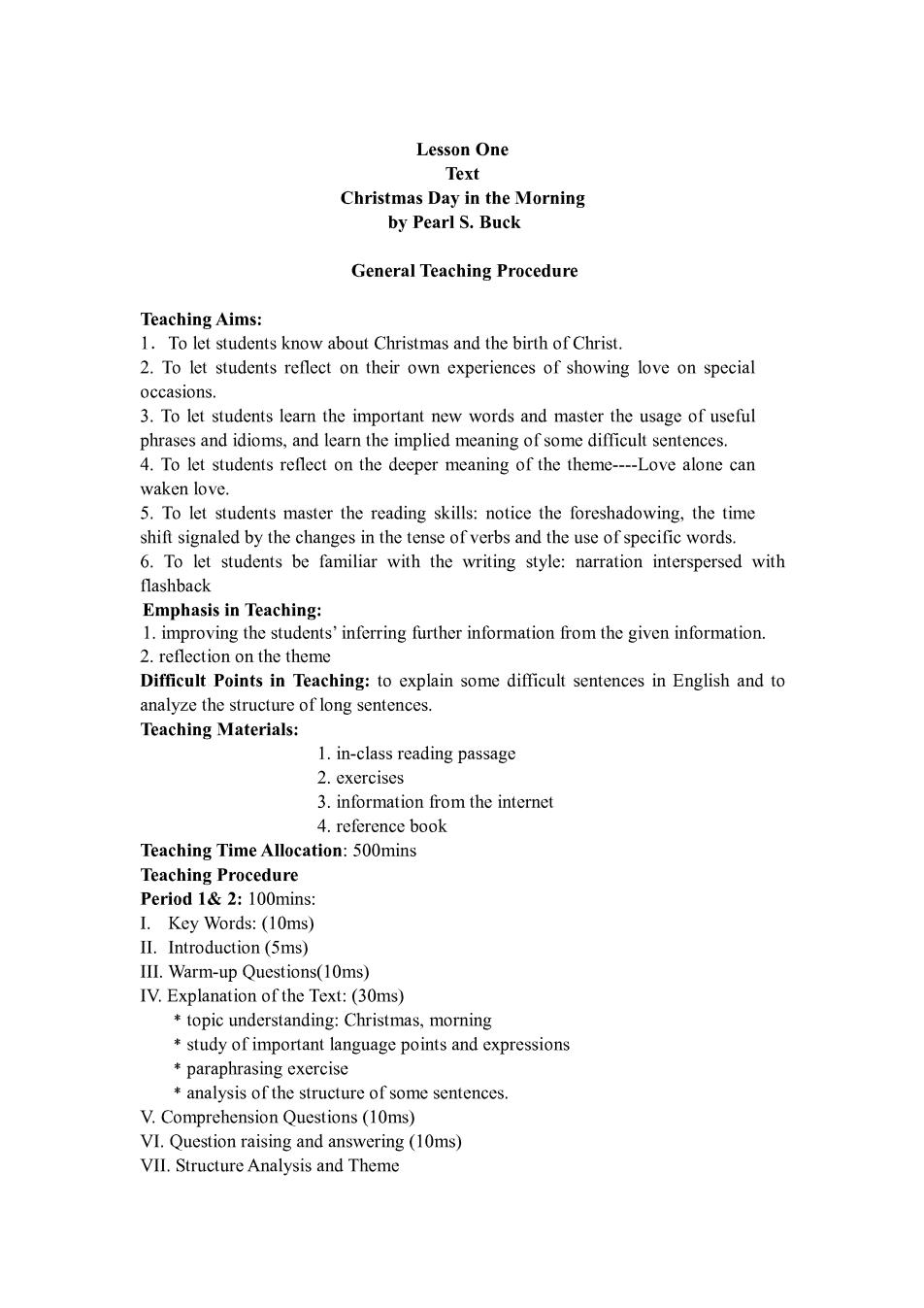
Lesson One Text Christmas Day in the Morning by Pearl S.Buck General Teaching Procedure Teaching Aims: 1.To let students know about Christmas and the birth of Christ. 2.To let students reflect on their own experiences of showing love on special occasions. 3.To let students learn the important new words and master the age of useful phrases and idioms,and earn the implied meaningof some difficult sentences. 4.To let students reflect on the deeper meaning of the theme- --Love alone can waken love. 5.To let students master the reading skills:notice the foreshadowing,the time shift signaled by the changes in the tense of verbs and the use of specific words. let students be amiliar with the writing stye: narratio interspersed with flashba Emphasis in Teaching: 1.improving the students'inferring further information from the given information. 2.reflection on the theme Difficult points in Teaching:to explain some difficult sentences in english and to tructure of long sentences 1.in-class reading passage 2.exercises 3.information from the internet 4 refer nce book Teaching Time Allocation:500 mins Teaching Procedure Period 1&2:100mins I Key Words:(10ms) IL Introduction (5ms) II.Warm-up Questions(10ms) IV.Explanation of the Text:(30ms) topic understanding:Christmas.morning study of important language points and expressions paraphrasing exercise analysis ofthe me sentences V.Comprehension Questions(10ms) VI.Question raising and answering(10ms) VII.Structure Analysis and Theme
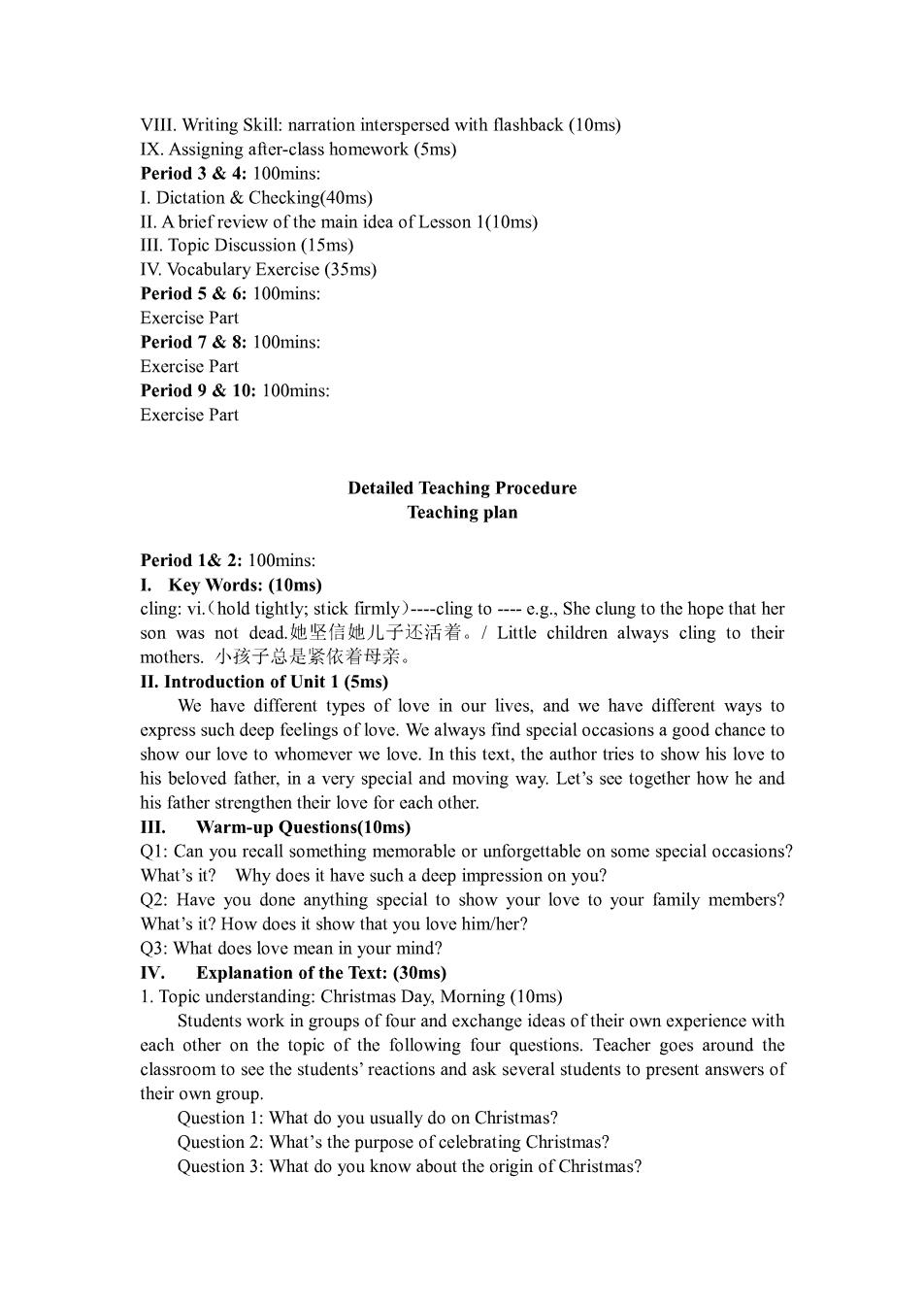
VIII.Writing Skill:narration interspersed with flashback (10ms) IX.Assig lass homework(5ms) I.Dictation Checking(40ms) Il.A brief review of the main idea of Lesson 1(10ms) IIL Topic Discussion (15ms) IV Vocabulary Exercise (35ms) Period 5&6:100mins: Exercise Par Period 7 8:100mins: Exercise Part Period 9&10:100mins Exercise Part Detailed Teaching Procedure Teaching plan Period 1&2:100mins: Key Words:(10ms) cling:vi.(hold tightly;stick firmly)- cling to - --e.g.She clung to the hope that her son was not dead.她坚信她儿子还活着。/Little children always cling to their mothers..小孩子总是紧依着母亲。 II.Introdu ction of Unit 1(5ms) We have different type of love in our lives,and we have different ways to express such deep feelings of love.We always find special occasions a good chance to show our love to whomever we love.In this text,the author tries to show his love to his beloved father,in a very special and moving way.Let's see together how he and his father strengthen their love for each other. Warm-up Questi s(10ms) Q1:Can you recall something memorable or unforgettable on some special occasions? What's it?Why does it have such a deep impression on you? Q2:Have you done anything special to show your love to your family members? What's it?How does it show that you love him/her? Q3:What does l in your mind? Explanation of the Text:(30ms) 1.Topic understanding:Christmas Dav,Morning (10ms) Students work in groups of four and exchange ideas of their own experience with each other on the topic of the following four questions.Teacher goes around the cral students to present answers of their own group Question 1:What do you usually do on Christmas? Question 2:What's the purpose of celebrating Christmas? Question 3:What do you know about the origin of Christmas?
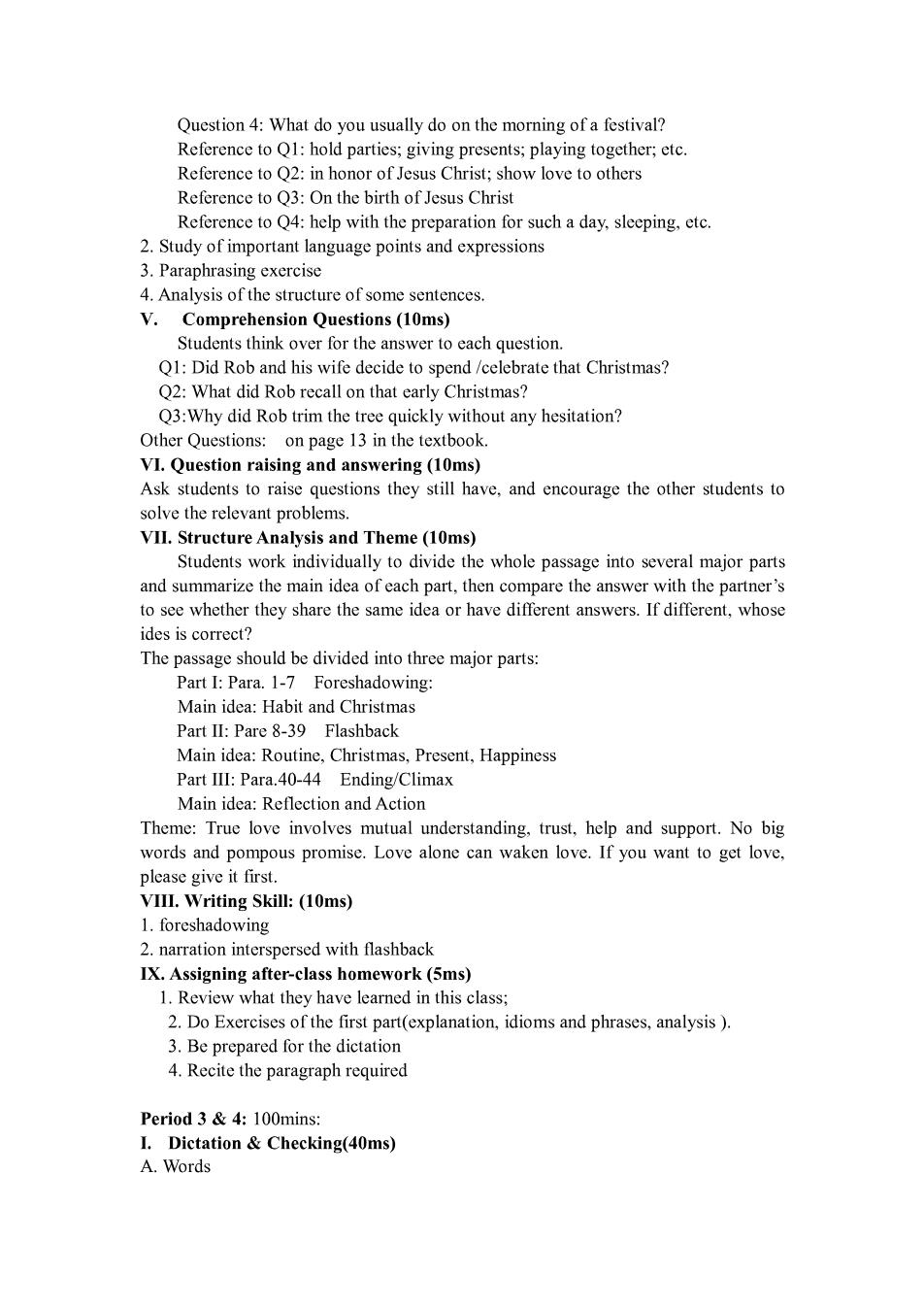
Question 4:What do you usually do on the morning of a festival? Q1:hold parties;giving presents;playn now love to others Reference to Q3:On the birth of Jesus Christ Reference to Q4:help with the preparation for such a day,sleeping.etc. 2.Study of important language points and expressions 3.Paraphrasing exercise 4.Analysis of the structure of some sente ences V. Comprel ion Questions (10ms) Students think over for the answer to each question Q1:Did Rob and his wife decide to spend /celebrate that Christmas? O2:What did Rob recall on that early Christmas? Q3:Why did Rob trim the equickly without any hesitation? Other Questions on page 13 in the textboc VI.Question raising and answering (10ms) Ask students to raise questions they still have,and encourage the other students to solve the televant problems VII.Structure Analysis and Theme(10ms) Studer k indivi lually to divide the whole passage into several major part and summarize the main idea of each part.then compare the answer with the partner's to see whether they share the same idea or have different answers.If different,whose ides is correct? The passage should be divided into three major parts: art I P ara.17 Main idea:Habit Part II:Pare 8-39 Flashback Main idea:Routine,Christmas,Present,Happiness Part IIl:Para.40-44 Ending/Climax Main idea:Reflection and Action Theme: True love involves mutual understanding,trust,help and support.No big words and pompous promise.Love alone can waken love.If you want to get love. please give it first. VIII.Writing Skill:(10ms) 1.foreshadowing 2.narration interspersed with flashback IX.Assigning after -class homework (5ms) 1.Review what they have learned in this class. 2.Do Exercises of the first part(explanation,idioms and phrases,analysis ) 3.Be prepared for the dictation 4.Recite the paragraph required Period 3&4:100mins: I.Dictation Checking(40ms) A.Words
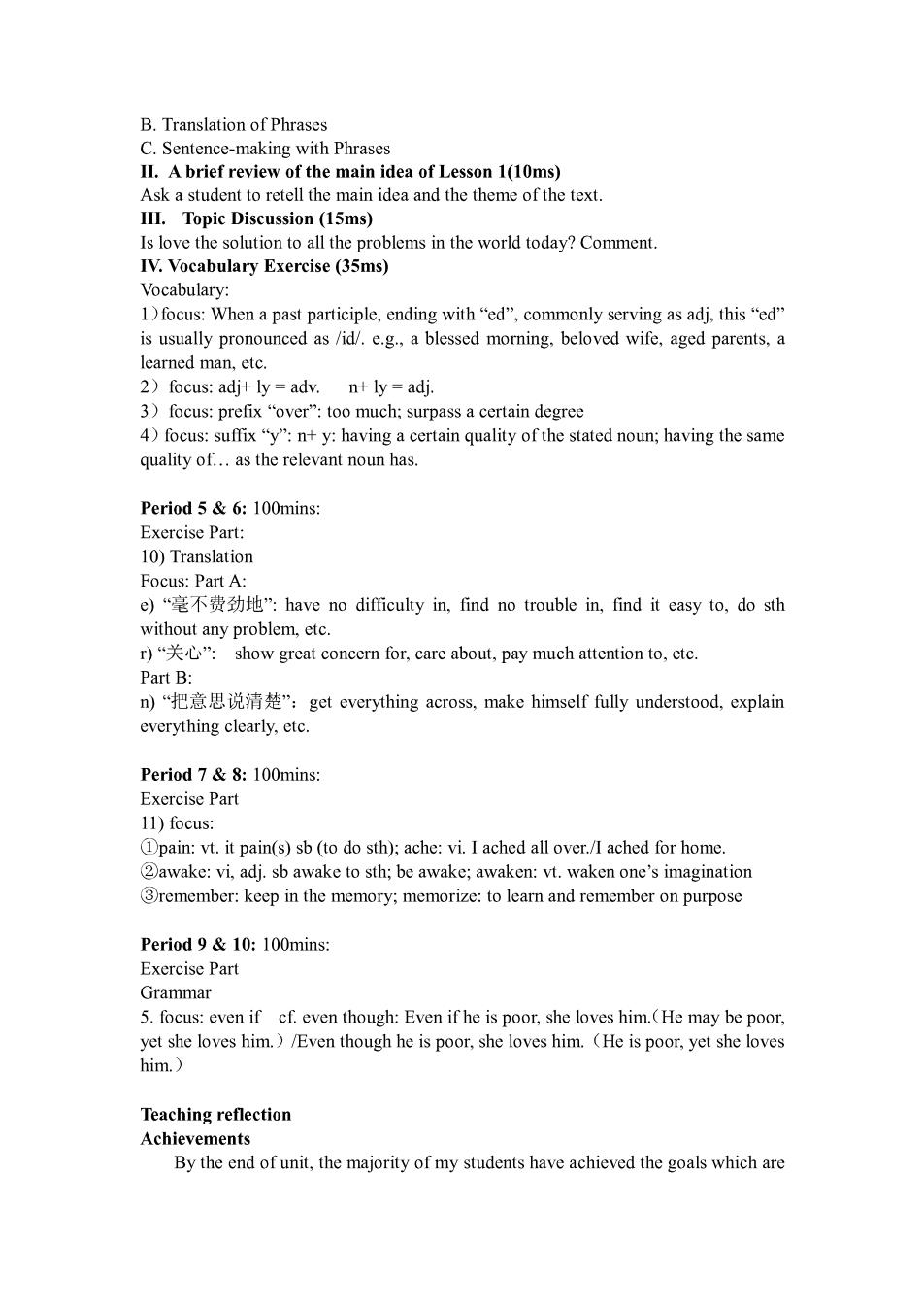
B.Translation of Phrases I.Aprier rmaking tite main idea of Lesson 1(10ms) a stu ent torete main idea and the theme ofthe tex III.Topic Discussion(15ms) Is love the solution to all the problems in the world today?Comment. IV.Vocabulary Exercise(35ms) Vocabulary: 1)focus:When a past participle,ending with"ed".commonly serving as adj.this"ed" is usually pronounced as /id e.g.,a bless ed morning,beloved e.aged parents.a learned man,ctc 2)focus:adi+ly adv. n+ly adi. 3)focus:prefix"over":too much;surpass a certain degree 4)focus:suffix"y":n+y:having a certain quality of the stated noun;having the same quality ofas the relevant nou n ha Period 5&6:100mins: Exercise part 10)Translation Focus part a e)毫不费劲地:have no dificully in,find no i find itasy o,dosh without any problem,etc. r)“关心”:show great concern for,.care about,.pay much attention to,ctc. Part B: n)“把意思说清楚”:get everything across,.make himself fully understood,.explain everything clearly,eto Period 7&8:100mins: Exercise Part 11)focus: pain:vt.it pain())ache: wake:vi,adj.sb awake to sth;be awake;awaken:vt.waken one's imagination 3remember:keep in the memory;memorize:to learn and remember on purpose Period 9&10:100mins: Exercise Part Gramma 5.focus:even if ef.even though:Even if he is poor,she loves him.(He may be poor. yet she loves him.)/Even though he is poor,she loves him.(He is poor,yet she loves him.) Teaching Achievements By the end of unit,the majority of my students have achieved the goals which are
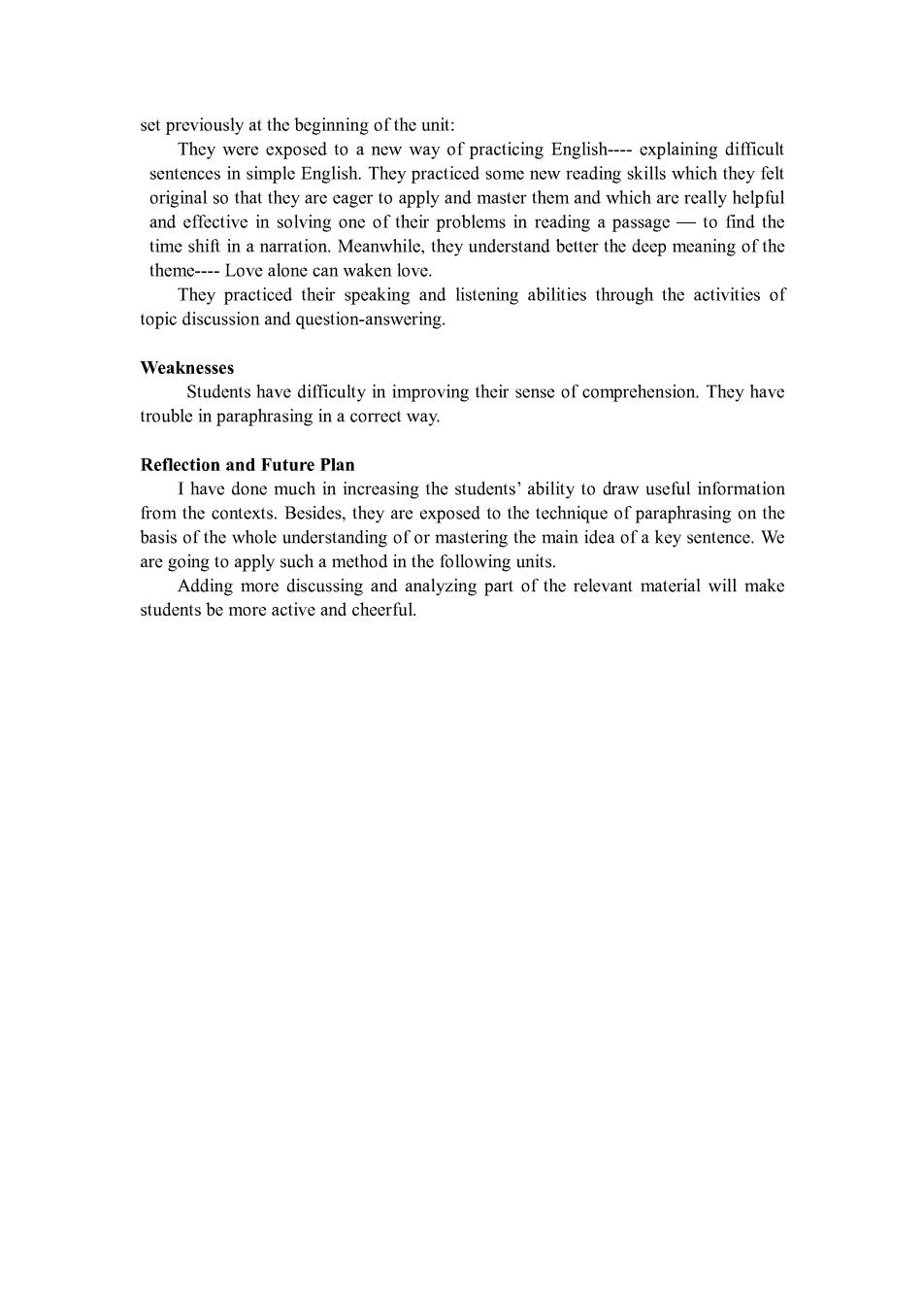
set previously at the beginning of the unit: They were exposed to a new way of practicing English--explaining difficult English.They practiced ew reading kil which they f original so that they are eager to apply and master them and which are really helpfu and effective in solving one of their problems in reading a passage-to find the time shift in a narration.Meanwhile,they understand better the deep meaning of the theme----Love alone can waken love. They practiced their speaking and listening abilities through the activities of topic discussion and question-answering. Weaknesses Students have difficulty in improving their sense of comprehension.They have trouble in paraphrasing in a correct way Reflection and Future Plan I have done much in increasing the students'ability to draw useful information from the contexts.Besides.they are exposed to the technique of paraphrasing on the hasis of the whole understandin nastering the main idea of a key sentence.We ch a method in the dingisusing and nalying part of the relevant mter i make students be more active and cheerful
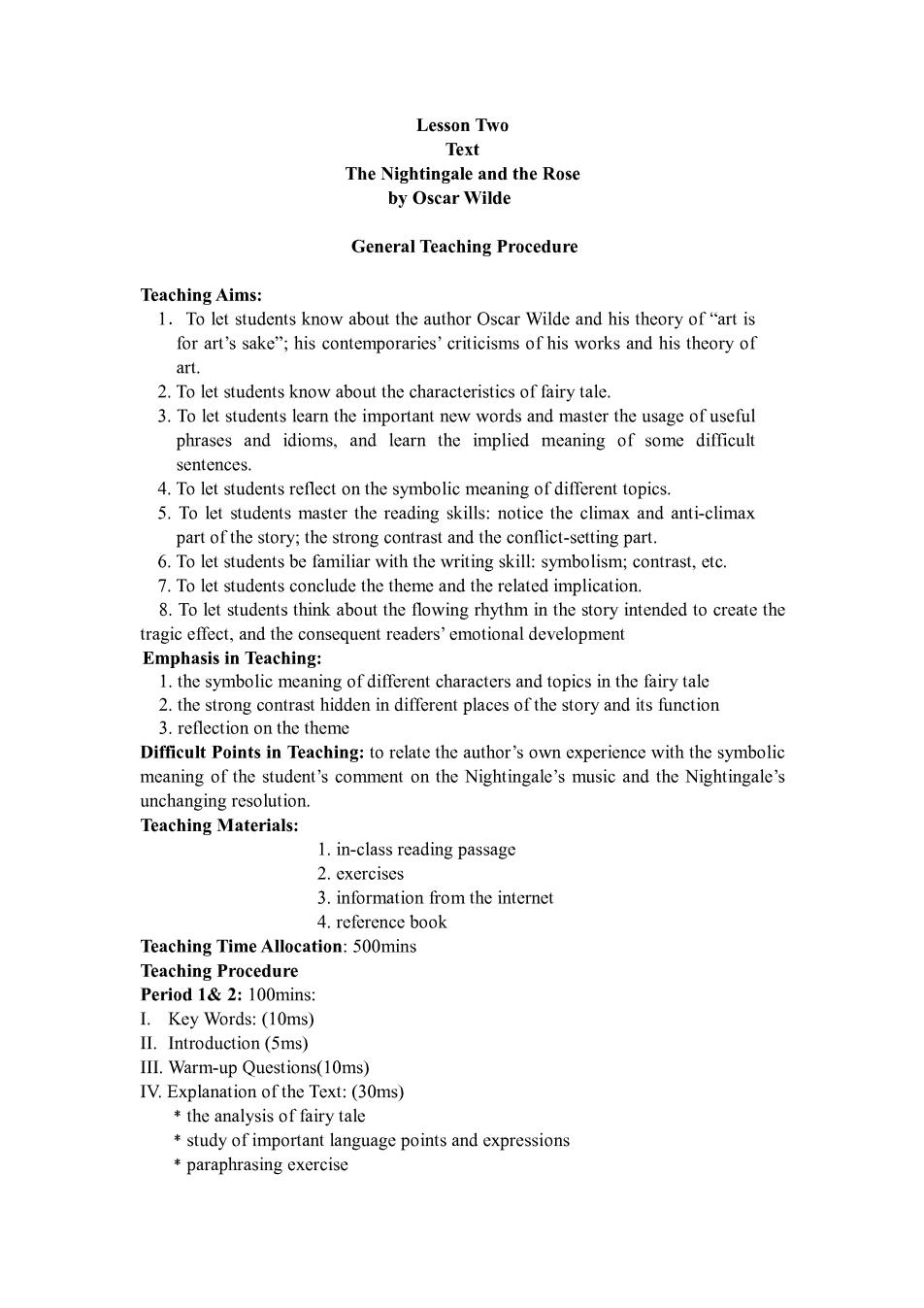
Lesson Two Text The Nightingale and the Rose by Oscar Wilde General Teaching Procedure Teaching Aims: 1.To let students know about the author Oscar Wilde and his theory of"art is for art's sake";his contemporaries'criticisms of his works and his theory of art 2.To let students know about the characteristics of fairy tale 3.To let students learn the important ew words and master the usage of useful phrases and idioms,and learn the implied meaning of some difficul sentences. 4.To let students reflect on the symbolic meaning of different topics. 5.To let students master the reading skills:notice the climax and anti-climax strong st and the onfict-setting part. wth thewitng ymbo onrat ete 7.To let students conclude the theme and the related implication. 8.To let students think about the flowing rhythm in the story intended to create the tragic effect.and the consequent readers'emotional development Emphasis in Teaching: the symbolic me tale 2.the strong cont reflection on the theme Difficult Points in Teaching:to relate the author's own experience with the symbolic meaning of the student's comment on the Nightingale's music and the Nightingale's unchanging resolution. Teaching Materials 1.in-class reading passage 2.exercises 3.information from the internet 4.reference book Teaching Time Allocation:500mins Teaching D I.Key Words:(10ms) II.Introduction(5ms) III.Warm-up Questions(10ms) IV.Explanation of the Text:(30ms) the analysis of fairy tale +study of important language points and expressions *paraphrasing exercise
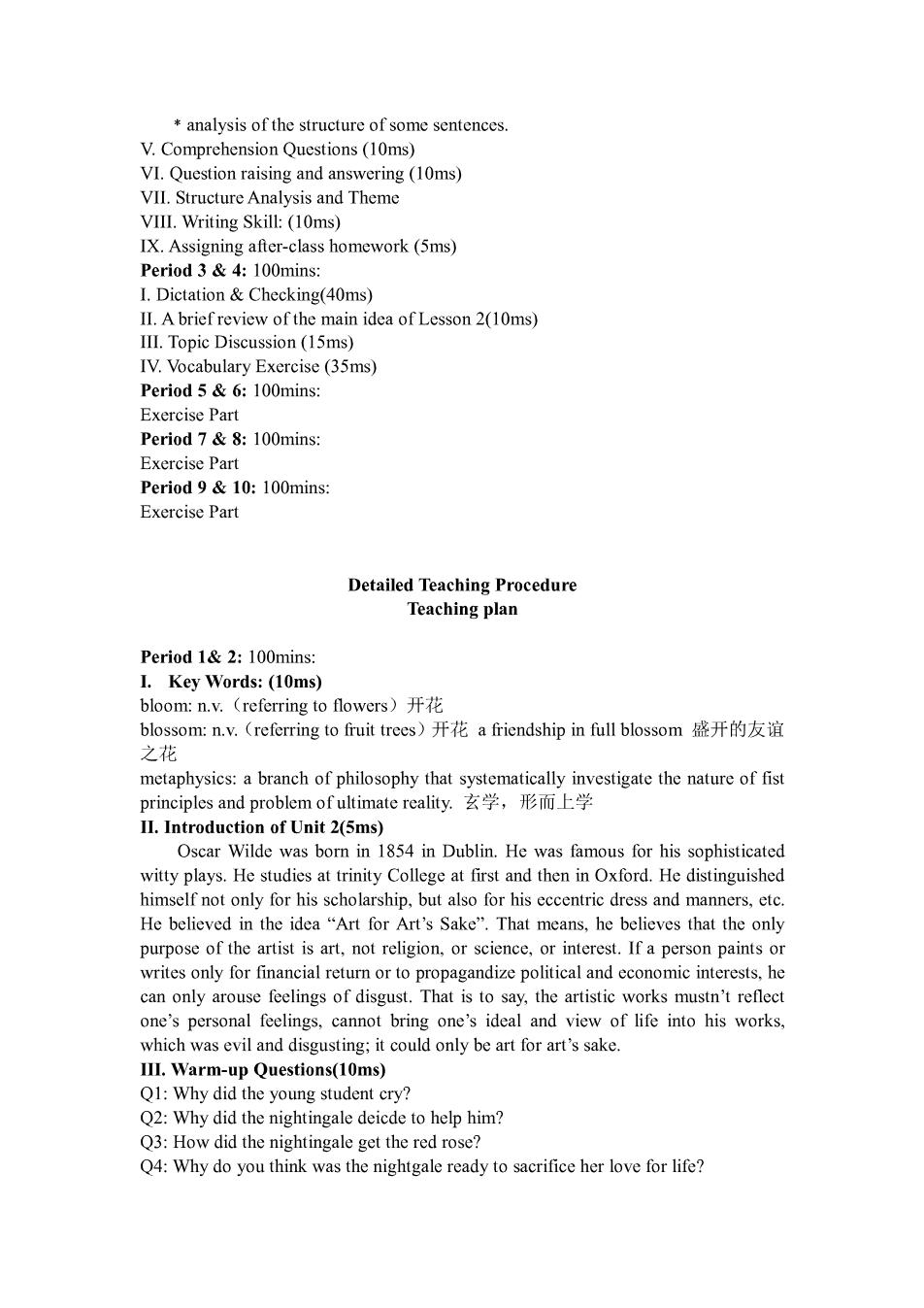
analysis of the structure of some sentences. VI.Question raising and answering(10ms VII.Structure Analysis and Theme VIII.Writing Skill:(10ms) IX Assigning after-class homework (5ms) Period 3 4:100mins: I.Dictation&Checking(40ms) II.A briefreview of the main idea of Lesson 2(10ms) III.Topic Discussion(15ms) IV.Vocabulary Exercise(35ms) Period 5&6:100mins: Exercise part Period7:100mins: Exercise Par Period 9 10:100mins: Exercise Part Detailed Teaching Procedure Teaching plan Period 1&2:100mins: I.Key Words:(10ms) bloom:n.v. (refe ming oflowers)开花 blossom:n...(referring to fruit trees)开花a friendship in full blossom盛开的友谊 之花 metaphysics:a branch of philosophy that systematically investigate the nature of fist principles and problem ofultimate reality..玄学,形而上学 on of Unit 2(5ms Oscar ilde was born in 1854 in Dublin.He was famous for his sophisticated witty plays.He studies at trinity College at first and then in Oxford.He distinguished himself not only for his scholarship,but also for his eccentrie dress and manners,ete. He believed in the idea "Art for Art's Sake".That means,he believes that the only Ifa person paintso can only arouse feelings of disgust.That is to say,the artistic works mustn't reflect one's personal feelings,cannot bring one's ideal and view of life into his works. which was evil and disgusting;it could only be art for art's sake. III.Warm-up Questions(10ms) 01:Wh did th e young stude cry Q2:Why did the nightingale deicde to help him? Q3:How did the nightingale get the red rose? Q4:Why do you think was the nightgale ready to sacrifice her love for life?
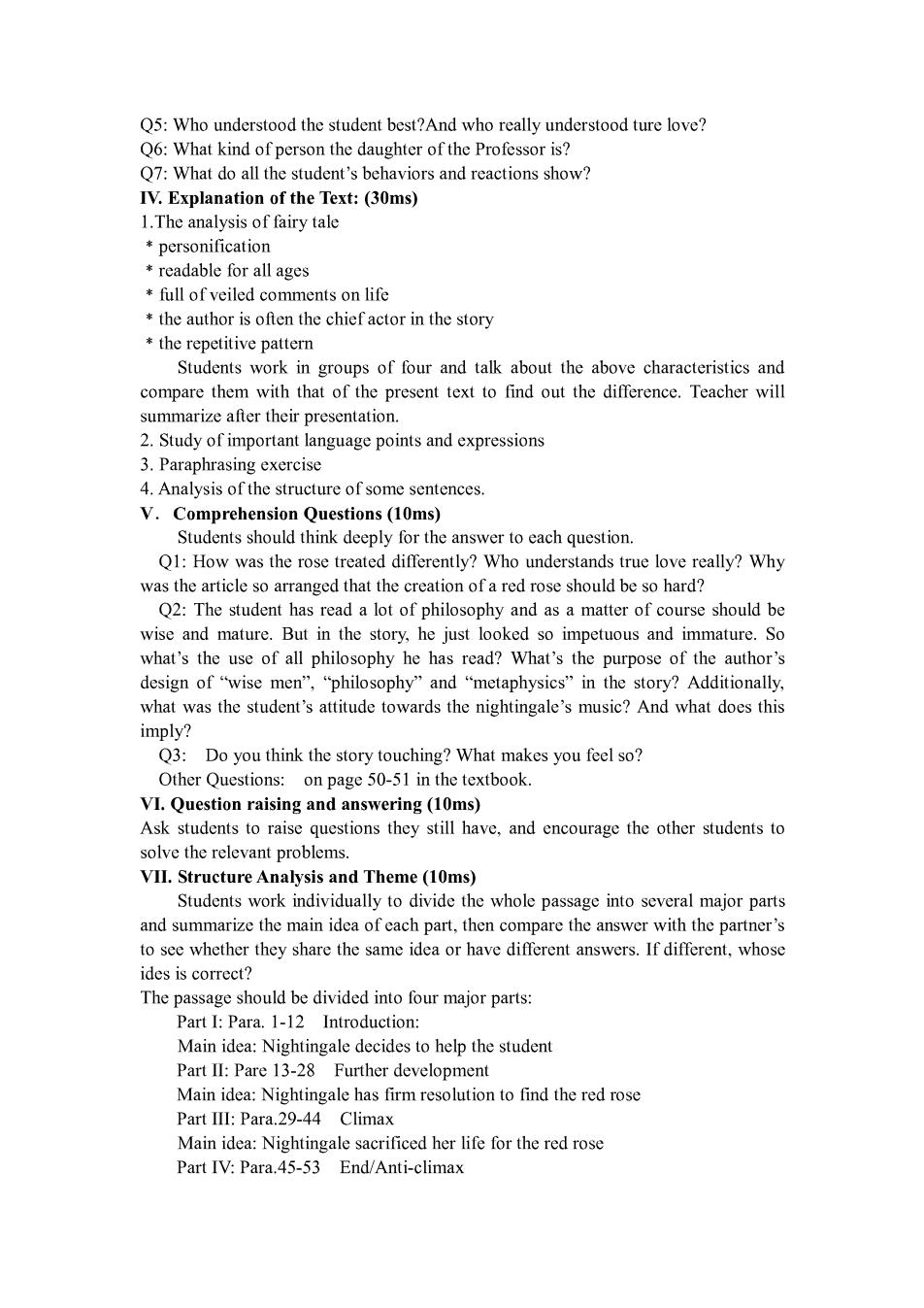
05:Who understood the student best?And who really understood ture love? or is? IV.Explanation of the Text:(30ms) 1.The analysis of fairy tale personification .rcadable for all age *full of veiled omments on life the author is often the chief actor in the story the repetitive pattern Students work in groups of four and talk about the above characteristics and compare them with that of the present text to find out the difference.Teacher will 2.Study of important language points and expressions 3.Paraphrasing exercise 4.Analysis of the structure of some sentences. V.Comprehension Questions(10ms) sho uld think de eply for the ar r to each question Who understands true love really?Why was the article so arranged that the creation of a red rose should be so hard? Q2:The student has read a lot of philosophy and as a matter of course should be wise and mature.But in the story,he just looked so impetuous and immature.So what's the use of all philosophy he has read?What's the purpose of the author's design of"wise men ”andn etaphysics”inth e story?A ddit onally what was the student's attitude towards the nightingale's music?And what does this imply? Q3:Do you think the story touching?What makes you feel so? Other Questions:on page 50-51 in the textbook. VI.Question raising and answering(10ms) Ask students to raise questions they still have,and encourage the other students to solve the relevant problems. VII.Structure Analysis and Theme(10ms) Students work individually to divide the whole passage into several maior parts and main idea of each are the answer wth the partner' tosee whether they share the same idea or have different answers.If different,whosc ides is correct? The passage should be divided into four major parts: Part I Para 1-12 Introduction: Main idea:nightingale decides to help the student Part II:Pare 13-28 Further development Main idea:Nightingale has firm resolution to find the red rose Part IIl:Para.29-44 Climax Main idea:Nightingale sacrificed her life for the red rose Part IV:Para.45-53 End/Anti-climax
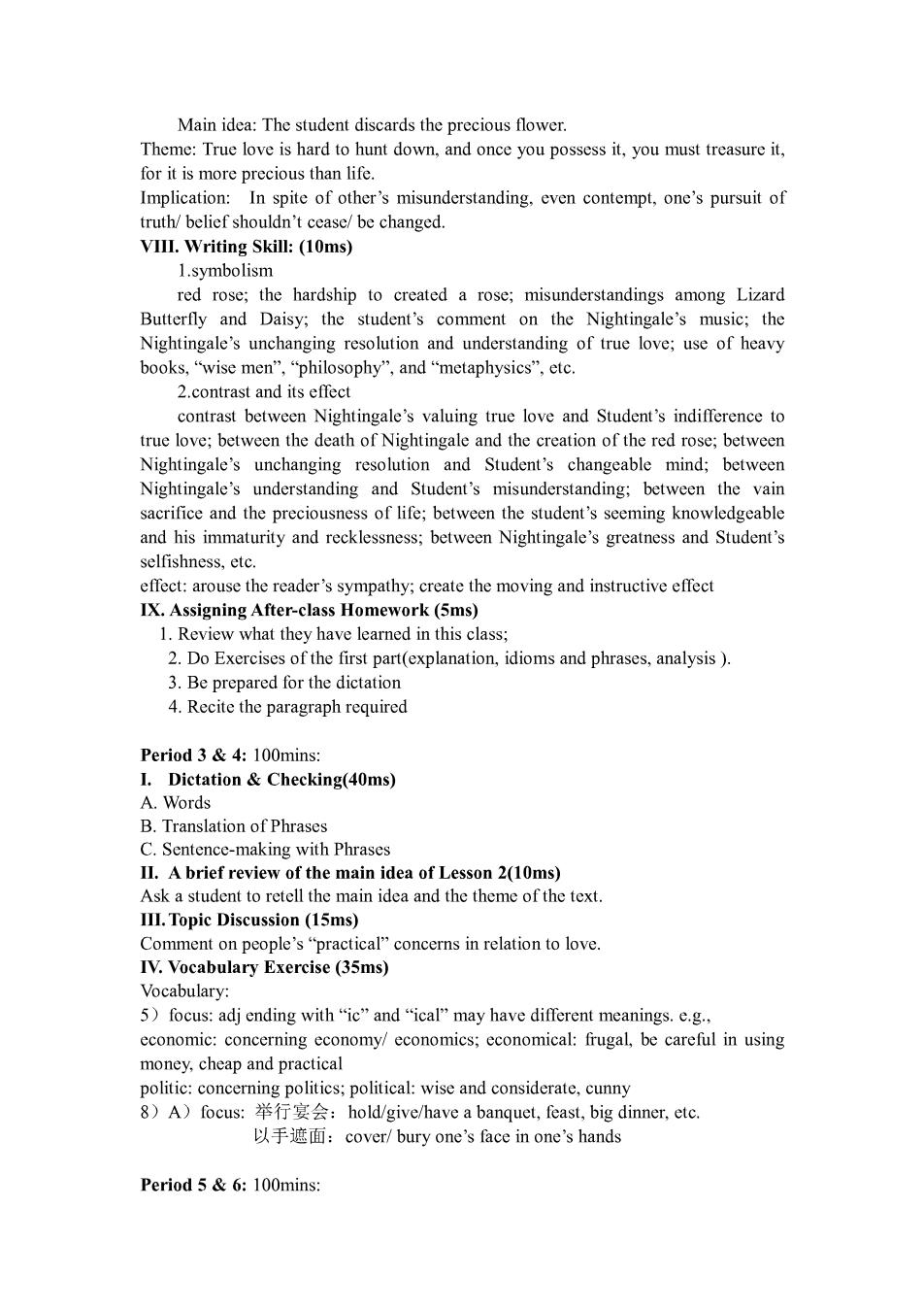
Main idea:The student discards the precious flower. Theme:True ove is hard to hunt down,and once you possess it you must treasure it for it is more precious than life Implication: In spite of other's misunderstanding.even contempt,one's pursuit of truth/belief shouldn't cease/be changed. VIII.Writing Skill:(10ms) 1.svmbolism among Lizard Butterfly and Daisy;the student's comment on the Nightingale's music:the Nightingale's unchanging resolution and understanding of true love:use of heavy books,“wise men”,"philosophy,and"metaphysics”,ctc. 2.contrast and its effect contrast between Nightingale's valuing rue love and Student's indifference true love:between the death of Nightingale and the creation of the red rose;betweer Nightingale's unchanging resolution and Student's changeable mind:between Nightingale's understanding and Student's misunderstanding;between the vain sacrifice and the preciousness of life;between the student's seeming knowledgeable and his immaturity and recklessness;between Nightingale's gr ess and Student's selfishness,et effect:arouse the reader's sympathy:create the moving and instructive effect IX.Assigning After-class Homework(5ms) 1.Review what they have learned in this class; 2.Do Exercises of the first part(explanation,idioms and phrases,analysis). Period 3 4:100mins: I.Dictation Checking(40ms) A.Words B.Translation of Phrases 工Aa5 ng vith Phr in idea of Lesson 2(10ms) Ask a student to retell III.Topic Discussion (15ms) Comment on people's"practical"concerns in relation to love. IV.Vocabulary Exercise (35ms) Vocabulary: 5)focus:adjending with"ic"and"ical"may have differ rent meani ings.e.g. economic:concerning economy/economics;economical:frugal,be careful in using money,cheap and practical politic:concerning politics;political:wise and considerate,cunny 8)A)focus:举行宴会:hold/give/have a banquet,feast,big dinner,etc. 以手遮面: cover/bury one's face in one's hands Period 5 6:100mins:

Exercise Part: 8)Translation Focus:Par b)“在黑夜中爬进了围墙而没有给敌人看见”:under the night cover/,at night/ because of the shelter of night,......climb/get /go over the wall without being seen by the enemies p)“每月工资的一半都用到吃的上面":half of the salary/monthly pay(carnings) goes for/is used for.to buy/has been spent on food 9)r)There's no going back:no route of retreat.c.f.go back on:Dbreak:~a promise:2be disloyal to:~sb Period 7&8:100mins: 10)locus i)be careful with put attention to when dealing with sth:Be careful with the vase: it's valuable. be careful ofabout:take care/show care in sth with the intention of avoiding danger: She is careful ofabout her food what she eats 11)focus c)suppress,oppress:"suppress"means to crush a stated action by force: disturbance/one's anger/important facts;or means to prevent from appearing;while "oppress"means to rule in a cruel way;or to cause to feel ill/sad. h)subtle.delicate:m ans hardly noticeable微妙的:a~taste,a~ mind(very clever in noticing&understanding):while"elicate"means easily broken hurt or needing careful treatment/tact,or likely to go wrong at any moment:a~ affair/position/subject/lady,etc. Period 9&10:100mins Exercise Part Grammar focus:inversion:to let the students know the cases in which inversion commonly occurs: 1.in sentence beginning with negative words or the words containing negative mcanings ositional phr ntai negative 2. in sentence eginning with prepositional phrases,and the predicate concerned indicates existence such as lie,stand,is,exist,ctc 3.in sentence beginning with adverbs such as out,in,up,down,her,there,forward, upward,backward.etc. 4.in sentence beginning with only which is followed by an adverbial(usu.a prep tional phrase) for rhetorical use such as the pre-positioning of adverbial or predicative. Teaching reflection Achievements